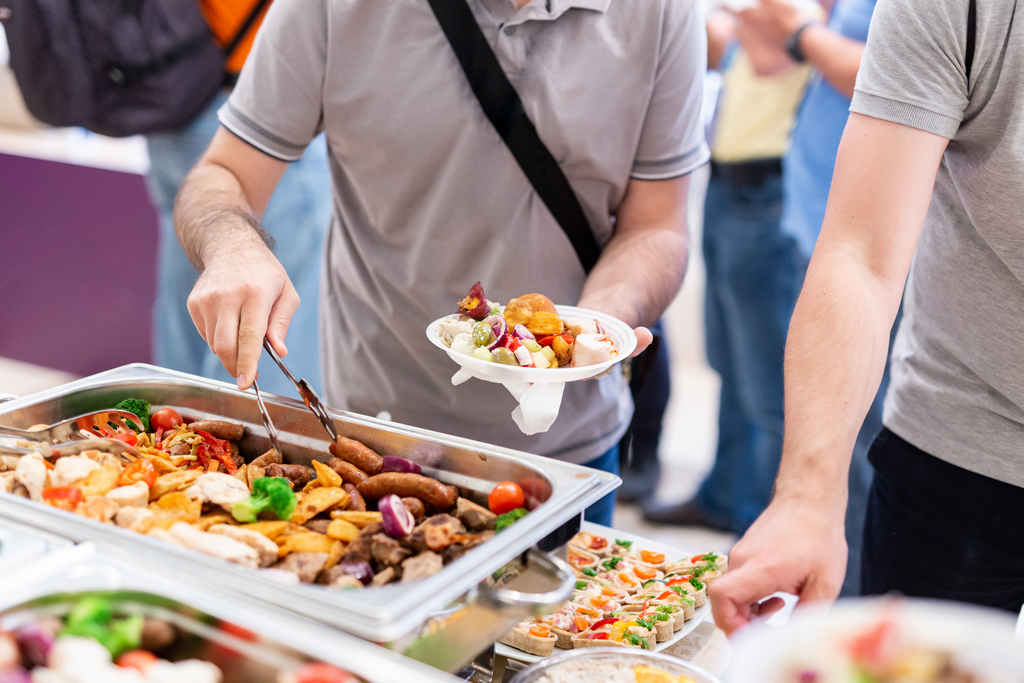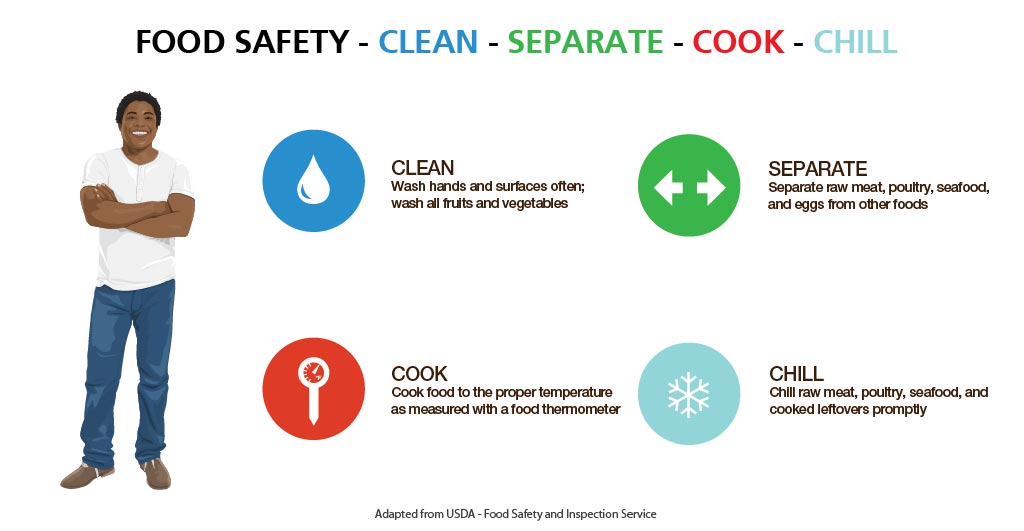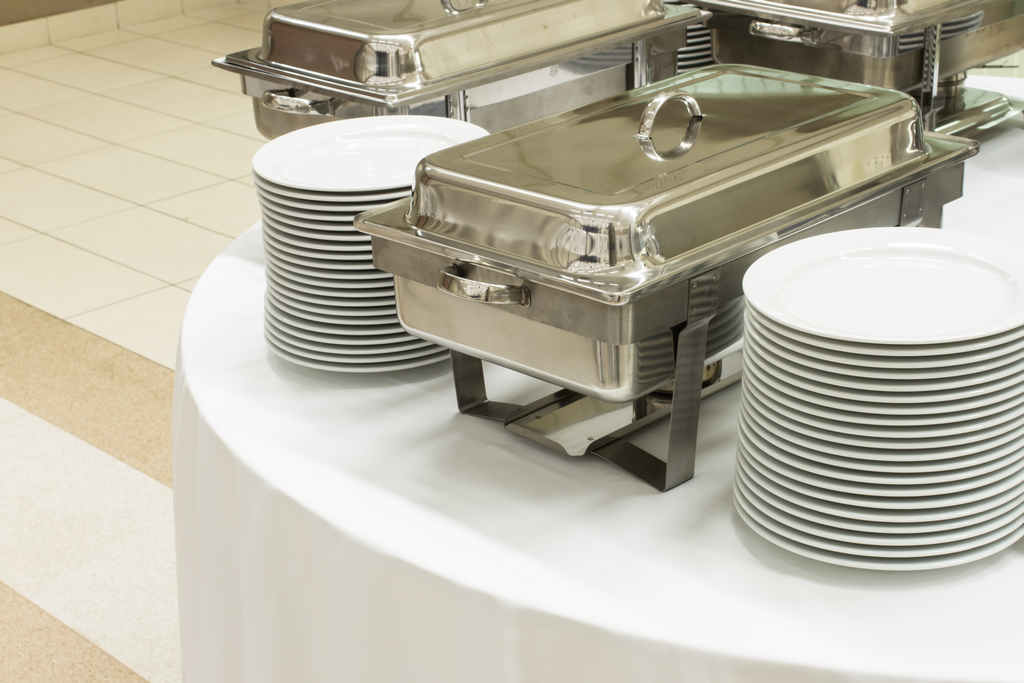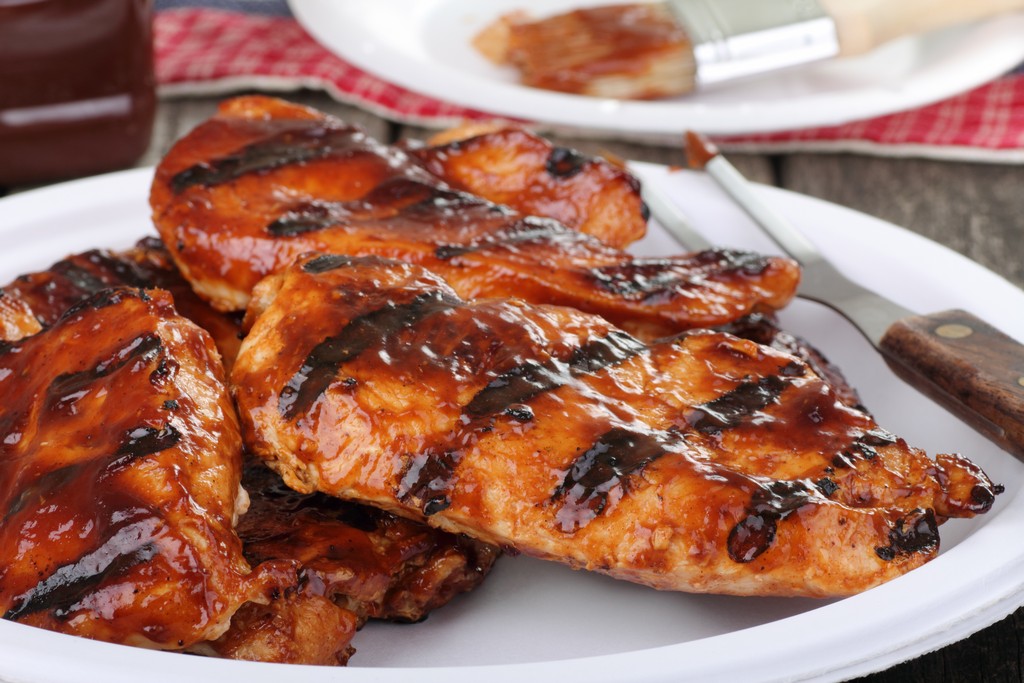Are you hiring a caterer or having a buffet for the big game? Make sure that the occasion is remembered for the great game and not a food illness.
Food safety is essential for those preparing and serving food for large groups of people. Keeping people food safe can only be achieved through proper food safety procedures and principles.



Catering Basic Food Safety Questions
Choosing a caterer doesn’t have to be stressful. Before hiring a caterer, learn more about the staff and if they understand food safety:
- Ask if the staff is trained and educated in food safety. Make sure food handlers have food safety training and the supervisor a food manager certification.
- Look at the caterer and staff’s clothing and uniforms. Appearance must be clean and long hair must be tied back. Likewise, gloves should be worn by all food handlers.
- Food Temperatures. It is important to note that all hot foods should be kept above 140˚F and cold food to be kept below 40˚F for food safety. If any of your catered foods falls outside this range for more than two hours, that food needs to be thrown away.
- Learn about proper hygiene, cross contamination, cold and hot food safety, foodborne pathogens, and best practices to prevent foodborne illness.
- Food Manager Training & ANSI Certification - $99.00
- Food Handler Training - only $7.00!
- HACCP Training: 16hr/4hr/1hr
- Food Allergy Training - $15.00
- Enter Promo "train10off" at Checkout
Make sure they follow food safety measures so your guests don’t get sick. Here are some addtional food safety questions to ask your caterer: (Source: USDA FoodSafety.gov)
- Are the staff members certified food handlers?
If they are certified, this means the staff is all properly trained on safe food handling. - How do you transport food to the venue?
You want to ensure cold foods stay cold and hot foods (pre-prepared), stay hot. If caterers transport unsealed food containers in the same compartment, spillage and cross-contamination may occur. Items containing perishable ingredients like beef can spill onto food dishes containing items like rice and potatoes. Caterers should use sealable containers. - When/where is the food prepared?
If the food is prepared off-site, ensure the caterers safely transport the food. If the food is prepared on-site, ensure the caterers have the appropriate tools they need to prepare and serve the food. Budget conscious couples may choose a venue without a “fully stocked” kitchen. When this happens, communicating this information to the caterer will ensure that they prepare by bringing with multiple knives, serving spoons, cutting boards, and dish towels. - How long after food—especially meat, poultry, seafood and eggs—is cooked is it brought out to guests?
Perishable foods should not sit out at room temperature for more than two hours. This will ensure that your guests are served a hot and, more importantly, safe meal. - How long does the buffet remain open and how will the caterer avoid the food entering the “danger zone”?
Ask the caterer to provide chafing dishes or warming trays to keep hot foods hot, and ice or other cold source to keep cold foods cold. Otherwise, food may enter the “danger zone,” between 40˚F and 140°F, where bacteria multiply rapidly. Never leave perishable foods in the “danger zone” for more than two hours; one hour in temperatures above 90°F. After two hours, food that has been sitting out should be replaced with fresh food. - Are there any potential allergens used in the preparation of the food?
You should certainly ask your caterer if there are any allergens in the dishes, including nuts, soy, milk, eggs, wheat and fish/shellfish. If there are, guests should be notified in some way. - Do you use a food thermometer to check that food is properly cooked?
The answer must be yes! No one (not even a caterer) can tell if meat is properly cooked by its color – they must use a meat thermometer. The FDA code pertaining to heated food stipulates that any food that needs to be reheated much reach an internal temperature of 165˚F for 15 seconds to be considered safe, therefore ensure that foods that were cooked offsite and transported while chilled are preheated accordingly.



Food Safety Principles and Procedures
Foodborne illness refers to human sickness or disease caused by consuming food or beverages contaminated with harmful biological, chemical, or physical hazards.
The Centers for Disease Control and Prevention (CDC) estimates that each year – 1 in 6 Americans (or 48 million people) become ill, 128,000 are hospitalized, and 3,000 die from contaminated foods or beverages.
Most foodborne illness incidents occur because of unsafe food preparation and handling. The main improper behaviors and practices are:
- Food from Unsafe Sources
- Improper Holding/Time and Temperatures
- Improper Cooking Temperatures
- Contaminated Equipment and Utensils
- Poor Employee Health and Hygiene



Begin by Keeping it Clean
Begin your party preparation by washing your hands with warm, soapy water for at least 20 seconds. Rewash hands and keep then clean – or wear disposable gloves throughout the stages of preparing meals.
Wash and sanitize dishware and utensils before using them to prepare, warm, cook or serve any foods.



Don’t Cross Contaminate
Don’t cross-contaminate your food. Cross-contamination is the transportation of harmful organisms or toxins to food by:
- Hands that touch raw foods, such as meat and poultry, then touch food that will not be cooked, like salad ingredients.
- Surfaces, like cutting boards or cleaning cloths, that touch raw foods, are not cleaned and sanitized, then touch ready-to-eat food.
- Raw or contaminated foods that touch or drip fluids on cooked or ready-to-eat foods.
- Utensils, such as knives, which cut raw foods, such as chicken, then cut ready-to-eat food such as lettuce.



Cook to the Proper Temperature
The FDA has temperature guidelines for minimum cooking temperatures and rest time for meat, poultry, seafood, and other cooked foods. Be sure to use a food thermometer to check whether meat has reached a safe internal temperature that is hot enough to kill harmful germs.
Here are the recommended internal temperatures for some party favorites:
- Chicken = 165°F
- Hot dogs, sausages = 165°F
- Ground Beef (Burgers), Pork, Veal & Lamb = 160°F
- Fish = 145°F
- Steak, chops, and roasts = 145°F
- Ham = 145°F
- Chili and Casseroles = 165°F
- Leftovers and Reheated Foods = 165°F



Watch the Time Food is Left Out
The game is over, but that doesn’t mean you have to lose your food or your health! Track the time that food stays on the buffet.
Foods can be kept safe by minimizing the time they spend in the temperature danger zone (41–135° F). When food is in the temperature danger zone, pathogens grow and multiply at a fast rate and can make food unsafe to eat.
Sideline any perishable foods that have been out at room temperature for 2 hours or more.



Foodborne Illness Signs and Symptoms
Foodborne bacteria, in large enough numbers, may cause food poisoning, symptoms similar to gastroenteritis or “stomach flu”. Some of the symptoms include stomach cramps, nausea, vomiting, diarrhea, and fever.
Foodborne illness symptoms can begin – as early as hours after – and as late as weeks after – the consumption of the contaminated food.



Vulnerable Groups
Anyone can get a foodborne illness, but people in certain groups are more likely to get sick and to have a more serious illness. These groups are:
- Young children
- Pregnant women
- Adults aged 65 and older
- People with weakened immune systems



Summary
Food safety is essential for those preparing and serving food for large groups of people. Keeping people food safe can only be achieved through proper food safety procedures and principles.









